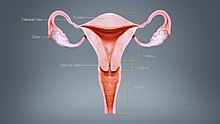User:Mr. Ibrahem/Amenorrhea
| Amenorrhea | |
|---|---|
| Other names | Amenorrhea, amenorrhœa |
 | |
| Diagram of the uterus, ovaries, and vagina | |
| Specialty | Gynecology |
| Complications | Mental health, osteoporosis, infertility[1] |
| Types | Primary, secondary[1] |
| Causes | Primary: Imperforate hymen, elevated FSH, prolactinoma, polycystic ovary syndrome[2] Secondary: Pregnancy, breastfeeding, thyroid problems, prolactinoma, anorexia, polycystic ovarian syndrome, ovarian insufficiency, hypogonadotropic hypogonadism[3] |
| Diagnostic method | Pregnancy test, blood tests, ultrasound[4] |
| Treatment | Depends on cause[1] |
| Prognosis | Not life threatening[1] |
| Frequency | 2% to 5% of women[2][3] |
Amenorrhea is the absence of menstrual periods in a female of reproductive age.[1] It is classified as primary if periods have not started by age 13 without sexual development, by age 15 in general, or if sexual development has begun and two years pass with no period.[4] It is classified as secondary when periods stop for at least six months in a female who has previously had periods.[3][5] It may result in mental health issues, osteoporosis, and infertility.[1]
Normal secondary causes are pregnancy, breastfeeding, and menopause.[3] Continuous use of hormonal birth control may also stop periods.[3] Amenorrhea may also occur due to a number of diseases.[6] Primary causes include anatomical problems such as an imperforate hymen or poorly developed uterus.[4] Other causes include abnormal hormonal levels such as elevated FSH or prolactinoma, and polycystic ovary syndrome.[2] It is possible to be pregnant before the first period.[4] Secondary causes include thyroid problems, high prolactinoma, anorexia, polycystic ovarian syndrome, ovarian insufficiency, and hypogonadotropic hypogonadism.[3]
Diagnosis is based on the symptoms, examination, blood tests, and sometimes medical imaging.[5] Pregnancy status should be determined.[1] Treatment depends on the underlying cause.[1] Amenorrhea is not life threatening.[1] Primary amenorrhea affects less than 1% of women in the United States while secondary amenorrhea, as a result of an underlying disease, affects 2% to 5%.[2][3]
References[edit]
- ^ a b c d e f g h i Nawaz, G; Rogol, A. D. (12 June 2023). "Amenorrhea". StatPearls. PMID 29489290. Archived from the original on 3 June 2023. Retrieved 2 November 2023.
- ^ a b c d Gasner, A; Rehman, A (30 March 2023). "Primary Amenorrhea". StatPearls. PMID 32119356. Archived from the original on 20 October 2022. Retrieved 3 November 2023.
- ^ a b c d e f g Lord, M; Sahni, M (18 July 2022). "Secondary Amenorrhea". StatPearls. PMID 28613709. Archived from the original on 15 January 2023. Retrieved 3 November 2023.
- ^ a b c d Smith, Roger P. (2023). "185. Primary amenorrhea". Netter's Obstetrics and Gynecology: Netter's Obstetrics and Gynecology (4th ed.). Philadelphia: Elsevier. pp. 415–416. ISBN 978-0-443-10739-9. Archived from the original on 2023-11-03. Retrieved 2023-11-03.
- ^ a b Master-Hunter T, Heiman DL (April 2006). "Amenorrhea: evaluation and treatment". American Family Physician. 73 (8): 1374–82. PMID 16669559. Archived from the original on 2008-07-23.
- ^ "Who is at risk of amenorrhea?". nichd.nih.gov/. Archived from the original on 2018-11-08. Retrieved 2018-11-08.
